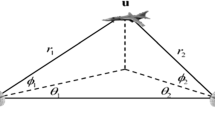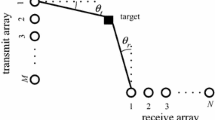Abstract
Starting from the generalized ambiguity function of bistatic SAR (BSAR), it is shown that 3-D point target estimation can be carried out in space-surface bistatic SAR (SS-BSAR). Appropriate analytical equations, based on maximum likelihood estimation (MLE), are derived and confirmed via computer simulation. Furthermore, the performance of the estimate using the Crammer-Rao bound is analyzed for the case in question, thus further revealing the possibility and potential of target 3-D position estimation. Setting the determinant maximum of the information matrix as the criterion, the optimal receiver position and multi-receiver configuration are analytically determined in the SS-BSAR system. Simulation results also validate the correctness of the analytical calculation.
Similar content being viewed by others
References
Carrara W G, Goodman R S, Majewski R M. Spotlight Synthetic Aperture Radar: Signal Processing Algorithms. Boston: Artech House, 1995. 55–72
Jakowatz C V, Thompson P A. A new look at spotlight mode synthetic aperture radar as tomography: imaging 3-D targets. IEEE Trans Image Process, 1995, 4(5): 699–703
Massonnet D, Feigl K, Rossi M, et al. Radar interferometric mapping of deforemation in the year after the Landers earthquake. Nature, 1994, 369(6477): 227–230
Zebker H A. The TOPSAR interferometric radar topographic mapping instrument. IEEE Trans Geosci Remote, 1992, 30: 933–940
Desai M D. Spotlight mode SAR stereo technique for height computation. IEEE Trans Image Process, 1997, 6: 1400–1411
Knaell K. Three-dimensional SAR from curvilinear apertures. In: Proceedings of the IEEE National Radar Conference. Ann Arbor: IEEE Press, 1996. 2230–2238
Chan H L, Yeo T S. Noniterative quality phase-gradient autofocus (QPGA) algorithm for spotlight SAR imagery. IEEE Trans Geosci Remote, 1998, 36(5): 1531–1539
Cherniakov M, Saini R, Zuo R, et al. Bistatic synthetic aperture radar with transmitters of opportunity. J Def Sci, 2005, 10(3): 136–140
Cherniakov M, Antoniou M, Saini R, et al. Space-surface BSAR: analytical and experimental study. In: EUSAR Conference. Dreden, 2006. 1–4
Cherniakov M. Space-surface bistatic synthetic aperture radar-prospective and problems. In: International Radar Conference. Edinburgh, 2002. 22–26
Nicholas J W. Bistatic radar. Boston: Artech House, 1991. 1–57
Paolo F, Leila G, Claudia I D, et al. A further insight into the potential of bistatic SAR in monitoring the earth surface. In: Geoscience and Remote Sensing Symposium. IEEE Press, 2003. 21–25
Brian D R, Randolph L M. Flight path strategies for 3-D scene reconstruction from Bistatic SAR. IEE Proc Radar Son Nav, 2004, 151(3): 149–157
Harry L V T. Detection, Estimation, and Modulation Theory. New York: John Wiley & Sons, 1997. 255–270
Merrill I S. RADAR Handbook. 2nd ed. Beijing: Beijing Publishing House of Electronics and Industry, 2003. 822–830
Cheng H, Cherniakov M, Tao Z. Isolated target 3-D position estimation in SS-BSAR. In: Radar Conference. IEEE Press, 2005. 546–551
Tao Z, Cherniakov M, Teng L. Generalized approach to resolution analysis in BSAR. IEEE Trans AES, 2005, 41(2): 461–474
Tison C, Nicolas J M, Tupin F. A new statistical model for Markovian classification of urban areas in high-resolution SAR images. IEEE Trans AES, 2004, 42, (10): 2046–2057
Author information
Authors and Affiliations
Corresponding author
Additional information
Supported by program for new century excellent talents in university (Grant No. NCET-06-0162)
Rights and permissions
About this article
Cite this article
Hu, C., Long, T. & Zeng, T. The possibility of isolated target 3-D position estimation and optimal receiver position determination in SS-BSAR. Sci. China Ser. F-Inf. Sci. 51, 1372–1383 (2008). https://doi.org/10.1007/s11432-008-0119-9
Received:
Accepted:
Published:
Issue Date:
DOI: https://doi.org/10.1007/s11432-008-0119-9




